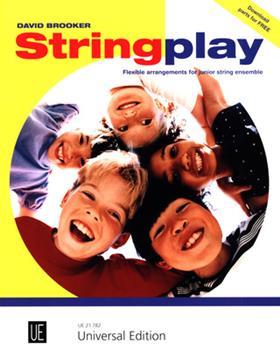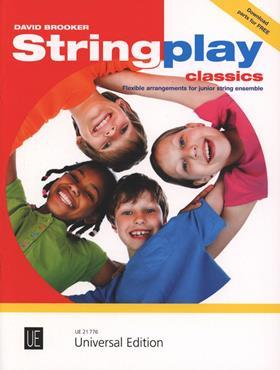Anne Inglis reviews the latest in David Brooker’s popular teaching series

Stringplay
David Brooker
18PP ISBN 9783702476168
UNIVERSAL EDITION £17.99

Stringplay Classics
David Brooker
22PP ISBN 9783702476076
UNIVERSAL EDITION £17.99
Nowadays, one-to-one music lessons in schools are for the few – and sadly, probably just as light on the ground are opportunities to play in groups. But it is group playing that can stimulate the child into further music making, and provide the fun of playing and performing with friends. Since the first Stringplay volume appeared in 2004, the market has benefited from additional good input, for example the Blackwells’ String Time Joggers, the Colledges’ series Simply 4 Strings and the delightful Vamoosh series. But the Stringplay family (Stringplay, Stringplay Around the World and the newly published Stringplay Classics) still holds its place in the repertoire and has grown from its format of score and separate printed parts (the ‘flexible arrangements for junior string ensemble’ instead of ‘….for beginners’) and the publications now appear as scores with downloadable parts.
In Stringplay, the parts are divided into melody, harmony, easy open string, and easy open string double bass for the first tune ‘Boogie Bass’ (cellists are expected to transpose the treble clef melody line down an octave here), and then the more detailed separate parts of indicated. There are editorial indications, e.g. ‘an easy double-stop for two open strings for violins’ or ‘the small notes require a position change’ – let’s hope that these comments are for the benefit of non-string teachers! The tunes in this first book are jolly and well tested: ‘This Old Man’ has enjoyable pizzicato in lower parts, and I like the ‘Square Dance’.
Stringplay Classics is similarly approachable, with some good strong tunes: ‘Handel Minuets’ (some overlap here with ‘Handel Suite’ in the Colledges’ Simply 4 Strings) and a march, Beethoven’s ‘Ode to Joy’, and Arbeau’s tried and tested ‘Les Bouffons’. Overall I like the attitude to arranging, with the options to start on easy/open string parts and progress to more difficult lines; viola parts are printed in alto clef, though always double the lower violin or cello, which is a pity. There are plenty of possibilities to keep beginners interested, and the sound is full with moving parts either by or with the melody. The piano parts are simple chords, and could be played by a Grade 2–3 pianist, allowing pupils to take control of the whole performance. The music is clearly printed. Ensemble coordinators can easily bring in additional instrumentalists.
ANNE INGLIS


































No comments yet